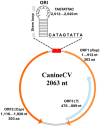Canine circovirus: emergence, adaptation, and challenges for animal and public health
- PMID: 40225762
- PMCID: PMC11987514
- DOI: 10.3389/fvets.2025.1535650
Canine circovirus: emergence, adaptation, and challenges for animal and public health
Abstract
Introduction: Canine circovirus (CanineCV) is an emerging pathogen with a significant impact on animal health and potential zoonotic risks. This study addresses its characterization, epidemiology, pathogenesis, and diagnostics, emphasizing its relevance within the One Health approach.
Background: The increasing detection of CanineCV across various species and regions highlights its genetic adaptability and cross-species transmission potential. Furthermore, growing interactions among domestic animals, wildlife, and humans amplify the need to understand its public and animal health implications.
Objective: To analyze the biology, epidemiology, and diagnostic challenges of CanineCV, focusing on its genetic evolution, interactions with co-infections, and implications for control strategies.
Methods: A systematic literature review was conducted, synthesizing data from epidemiological, genomic, and clinical studies. Molecular techniques, such as PCR and qPCR, were evaluated for their efficacy in virus detection and quantification.
Results: Canine circovirus exhibits high genetic variability and has been detected in diverse species and tissues. Co-infections, including parvovirus and adenovirus, exacerbate clinical signs, primarily gastrointestinal, and respiratory. Advances in diagnostics, such as real-time PCR and in situ hybridization, have demonstrated increased sensitivity in viral detection.
Conclusion: Canine circovirus poses a growing challenge to animal health and a potential threat to public health due to its genetic plasticity and adaptability to multiple hosts. Continuous research is essential to understand its pathogenesis, develop effective control measures, and mitigate risks in diverse ecosystems.
Keywords: CanineCV; Circoviridae; Porcine circovirus; emerging; pig disease; public health.
Copyright © 2025 Silva, Ciola, Lopes, Matias, Oliveira and Castro.
Conflict of interest statement
The authors declare that the research was conducted in the absence of any commercial or financial relationships that could be construed as a potential conflict of interest.
Figures





References
-
- Felipetto LG, Fernandes FD, Vogel FSF, Flores EF, Botton SA, Sangioni LA. Demographics and health care profiles of dogs and cats associated with the socioeconomic profile of their tutors in areas assisted by Family Health Strategies in Brazil. Arq Bras Med Vet Zootec. (2022) 74:1007–16. 10.1590/1678-4162-12708 - DOI
-
- Albert A, Bulcroft K. Pets, families, and the life course. J Marr Fam. (1988) 50:543. 10.2307/352019 - DOI
-
- Solhjoo N, Krtalić M, Goulding A. Pets and people: information experience of multispecies families. J Document. (2022) 78:1092–108. 10.1108/JD-03-2021-0052 - DOI
-
- Queiroz FCBP, Lima NC, da Silva CL, da Silva CL, Queiroz J, de Souza GHS. Purchase intentions for brazilian recycled PET products—circular economy opportunities. Recycling. (2021) 6:75. 10.3390/recycling6040075 - DOI
Publication types
LinkOut - more resources
Full Text Sources

